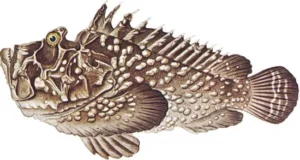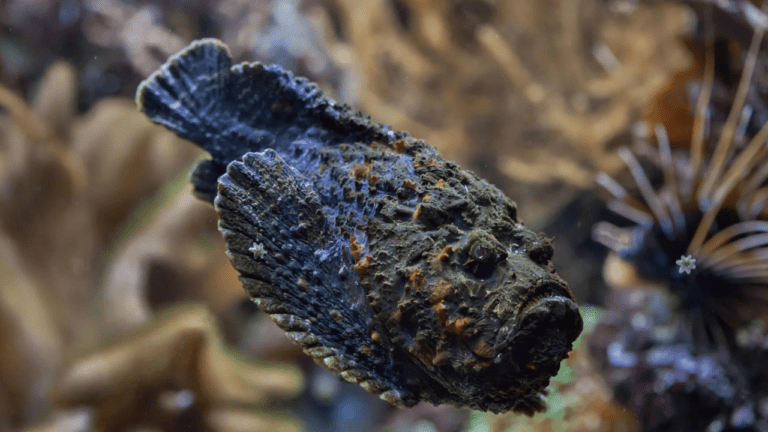The underwater world is home to a myriad of fascinating and often mysterious creatures, but few are as intriguing as the stonefish. This unassuming-looking fish is a true master of camouflage and possesses one of the most potent venoms in the animal kingdom. In this blog post, we will dive deep into the world of stonefish, exploring their incredible adaptations, their unique hunting techniques, and the importance of understanding and protecting these remarkable creatures.
The Stonefish’s Appearance
-
Camouflage Mastery
The Stonefish (Synanceia spp.) is a true master of camouflage in the underwater world. Its ability to blend seamlessly into its surroundings is nothing short of astonishing. This remarkable skill is primarily a matter of life and death for the stonefish, as it is one of the most venomous fish in the ocean, and it relies on its camouflage to both ambush prey and avoid predators.
One of the key features that contribute to the stonefish’s camouflage mastery is its rough, textured skin. Covered in various bumps, spines, and warts, the stonefish’s skin resembles the texture of the rocks and coral it typically inhabits. This texture not only helps break up its outline but also provides an uncanny resemblance to the surrounding environment.
Furthermore, the stonefish’s coloration is another essential element of its camouflage. It can vary greatly depending on its habitat, ranging from shades of brown, grey, green, or even red. This adaptability allows it to match the specific colors of the substrate it resides on, making it nearly invisible to the naked eye.
-
Physical Characteristics
In addition to its camouflage prowess, the stonefish boasts a unique set of physical characteristics that further aid in its survival. One of the most distinctive features is its flat body shape, which allows it to lie almost flush with the ocean floor. This low-profile body shape minimizes shadows and makes it incredibly challenging for both prey and predators to detect.
The stonefish’s dorsal fin spines are another defining feature. These spines, which are laden with potent venom, are usually hidden but can be erected when the fish feels threatened. They resemble a row of thorny projections, adding to the overall camouflage effect and serving as a formidable defense mechanism.
Its large, lidless eyes are adapted to spot prey and potential threats, even in low-light conditions. This keen eyesight helps the stonefish remain vigilant while waiting patiently for prey to come within striking distance.
-
How They Blend Into Their Environment
Stonefish excel at blending into their environment by using both coloration and texture to their advantage. Their ability to change color slightly over time allows them to adapt to different backgrounds, ensuring they remain well-camouflaged no matter where they choose to reside. This adaptability is particularly important for their survival, as they often inhabit coral reefs, rocky crevices, or sandy bottoms, each with its unique color palette.
Their preference for remaining motionless for extended periods is another tactic that aids in their camouflage. By staying still, stonefish minimize any disturbances that might give away their presence. They rely on their ambush hunting strategy, waiting for prey to swim by before striking with lightning speed.

Distribution and Habitat
-
Where Stonefish Are Found
Stonefish, known for their incredible camouflage and deadly venom, have a widespread distribution across various marine environments. These fascinating creatures can be found in several regions around the world, primarily in warm, tropical waters. Some of the key areas where stonefish are commonly found include:
- Indo-Pacific Region: Stonefish are abundant in the Indo-Pacific, which includes locations like the Great Barrier Reef in Australia, the Philippines, Indonesia, and the Maldives.
- Indian Ocean: They can be spotted in the Indian Ocean, along the eastern coast of Africa, the Red Sea, and the Arabian Sea.
- South Pacific: Stonefish are also prevalent in the South Pacific, including places like Fiji, Vanuatu, and New Caledonia.
- South China Sea: This region is another hotspot for stonefish sightings.
- North Australia: They are frequently encountered along the northern coast of Australia, especially in Queensland.
- Caribbean Sea: While less common, some stonefish can be found in the Caribbean Sea, particularly in the waters of the Lesser Antilles.
-
Preferred Habitats
Stonefish are highly adaptable and can inhabit a range of marine environments, but they do have preferences for specific habitats that suit their unique hunting and survival strategies. Some of their preferred habitats include:
- Coral Reefs: Stonefish are often associated with coral reefs, where their textured skin and color-changing abilities allow them to blend seamlessly with the coral formations. They use these reefs as both hunting grounds and hiding spots.
- Rocky Substrates: These fish are also commonly found near rocky substrates, where they can easily mimic the rocky texture using their skin. This provides ample hiding places and ambush opportunities.
- Sandy or Muddy Bottoms: Stonefish can be found in areas with sandy or muddy bottoms as well. In such environments, they bury themselves partially in the substrate, leaving only their dorsal spines exposed, ready to strike unsuspecting prey.
- Seagrass Beds: Some species of stonefish can be found in seagrass beds, where they adapt their coloration to match the seagrass blades and ambush small fish or crustaceans that venture too close.
Video Credit – Brave Wilderness (YT Channel)
-
How They Choose Their Hiding Spots
Stonefish are highly selective when it comes to choosing their hiding spots. Their decisions are based on several factors, including camouflage opportunities, proximity to prey, and protection from predators. Here’s how they go about selecting their hiding spots:
- Camouflage: Stonefish choose locations where their appearance can be best camouflaged. They often select spots with a substrate that closely matches their color and texture, making it difficult for both prey and predators to detect them.
- Proximity to Prey: These ambush predators select hiding spots strategically near areas where potential prey is likely to pass by. They patiently wait for their prey to swim within striking distance.
- Protection: Stonefish also seek hiding spots that provide some protection from predators. Their dorsal fin spines are a potent deterrent, but they still prefer locations where they can quickly retreat if threatened.
- Environmental Factors: Environmental conditions, such as water temperature and current patterns, can influence their choice of hiding spots. They tend to favor areas with suitable conditions for their survival.
Venomous Defense
→ The Potency of Stonefish Venom
The stonefish is renowned for having one of the most potent venoms in the animal kingdom. Its venom is primarily defensive, serving as a powerful deterrent against potential predators and a means to immobilize prey. The venom is produced by specialized glands located within the grooves of its dorsal fin spines, which are capable of delivering the venomous payload when triggered.
The potency of stonefish venom is due to a complex mixture of proteins and peptides, including enzymes, neurotoxins, and myotoxins. These substances work in tandem to induce severe pain, paralysis, tissue damage, and even death in some cases. Stonefish venom is particularly effective at subduing prey and deterring would-be predators.
How They Deliver Their Venom
Stonefish deliver their venom through the sharp spines on their dorsal fin, which are equipped with venom glands. These spines are usually hidden, lying flat against the fish’s body. However, when the stonefish feels threatened or is stepped on, it erects these spines as a defensive mechanism.
When pressure is applied to the spines, such as when someone steps on the fish, the spines puncture the skin and release the venom into the wound. The venom then enters the victim’s bloodstream, where its potent components begin to take effect. The speed at which the venom is delivered, combined with its potency, makes stonefish stings extremely dangerous.
The Effects of a Stonefish Sting on Humans
A stonefish sting on a human can be excruciatingly painful and, in some cases, life-threatening if not treated promptly. The effects of a stonefish sting typically include:
- Immediate, Intense Pain: The venom causes immediate and severe pain at the site of the sting. The pain can be so intense that it often leads to shock or loss of consciousness in some individuals.
- Swelling and Bruising: Swelling and bruising may occur around the sting site due to the venom’s impact on blood vessels and surrounding tissues.
- Necrosis: In severe cases or with delayed treatment, the venom can lead to tissue death (necrosis) around the wound.
- Systemic Symptoms: Some individuals may experience systemic symptoms, such as nausea, vomiting, weakness, and even paralysis, as the venom spreads through the body.
- Cardiovascular and Respiratory Complications: In rare instances, severe envenomation can lead to cardiovascular and respiratory complications, posing a serious threat to the victim’s life.
Immediate first aid and medical attention are crucial when someone is stung by a stonefish. The primary treatment involves immersing the affected area in hot water (not scalding) to help alleviate pain and inactivate some of the venom’s proteins. Pain relief and antivenom therapy may be necessary, particularly in severe cases.
FAQs about Stonefish
-
Are Stonefish deadly to humans?
Yes, Stonefish can be deadly if stepped on or touched. Their venomous spines can cause severe pain and even lead to fatalities if not treated promptly.
-
How can one avoid Stonefish stings?
To avoid Stonefish stings, it’s essential to be cautious when walking in shallow waters, especially near rocky or coral-filled areas. Wearing protective footwear can provide some defense against accidental encounters.
-
What is the range of Stonefish habitat?
Stonefish are primarily found in the Indian and Pacific Oceans, with their range extending from the coasts of Africa to the waters of Australia and Southeast Asia.
-
Do Stonefish have any predators?
While Stonefish are masters of camouflage and venom, they are not invincible. Some larger predatory fish, such as groupers, have been known to prey on them.
-
How do Stonefish reproduce?
Stonefish reproduce through external fertilization. Females release their eggs, and males fertilize them in open water. The fertilized eggs eventually settle on the ocean floor.
-
Are there different species of Stonefish?
Yes, there are several species of Stonefish, each with its unique characteristics and adaptations. Some of the most well-known species include the reef stonefish and the estuarine stonefish.
Conclusion
In the depths of our oceans, hidden from the casual observer, the stonefish reigns as a remarkable and enigmatic creature. Its unparalleled mastery of camouflage, combined with its lethal venom, makes it a captivating subject of study. Stonefish, with their unique adaptations, remind us of the incredible diversity of life beneath the waves.
While stonefish may be awe-inspiring, they also face numerous threats, from habitat degradation to overfishing. As responsible stewards of our planet, it is our duty to protect these elusive creatures and the fragile ecosystems they inhabit. By understanding the stonefish’s importance in our oceans, we can work together to ensure their survival.
So, the next time you find yourself by the coast or exploring the depths of the ocean, remember the stonefish and the countless other fascinating species that call the sea their home. Their existence is a testament to the wonders of nature, and it is up to us to ensure that these wonders endure for generations to come.



